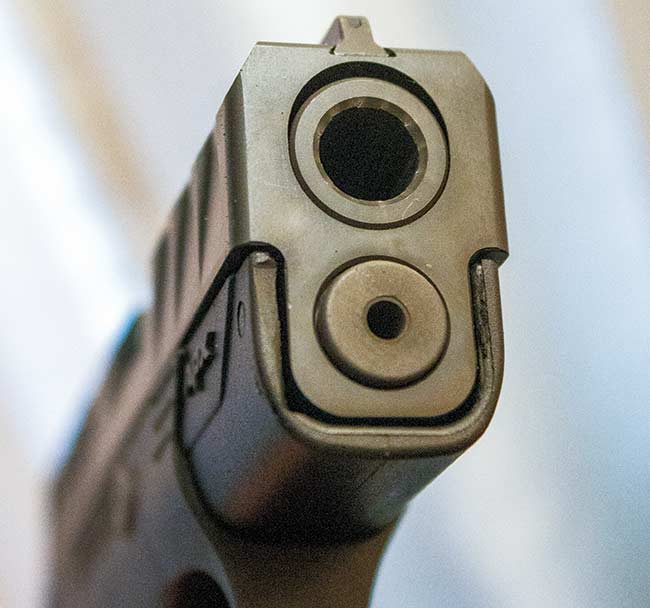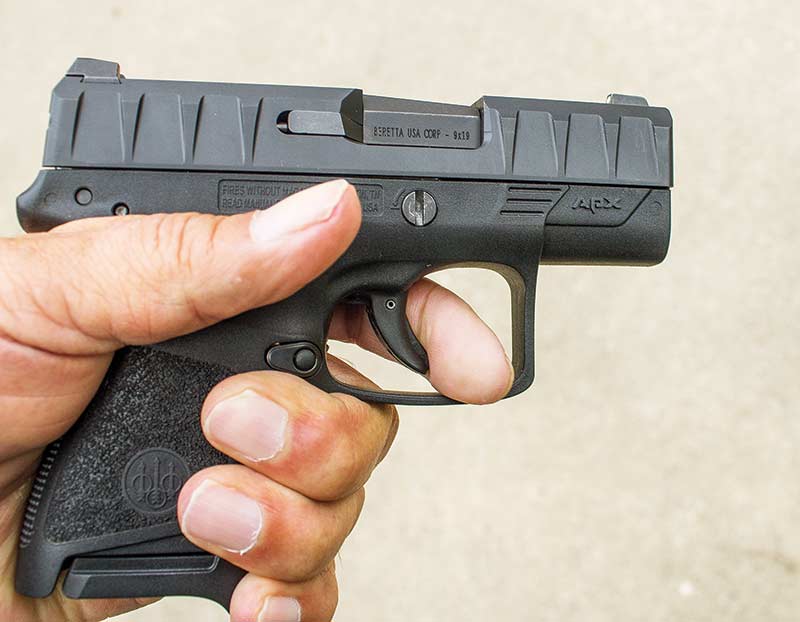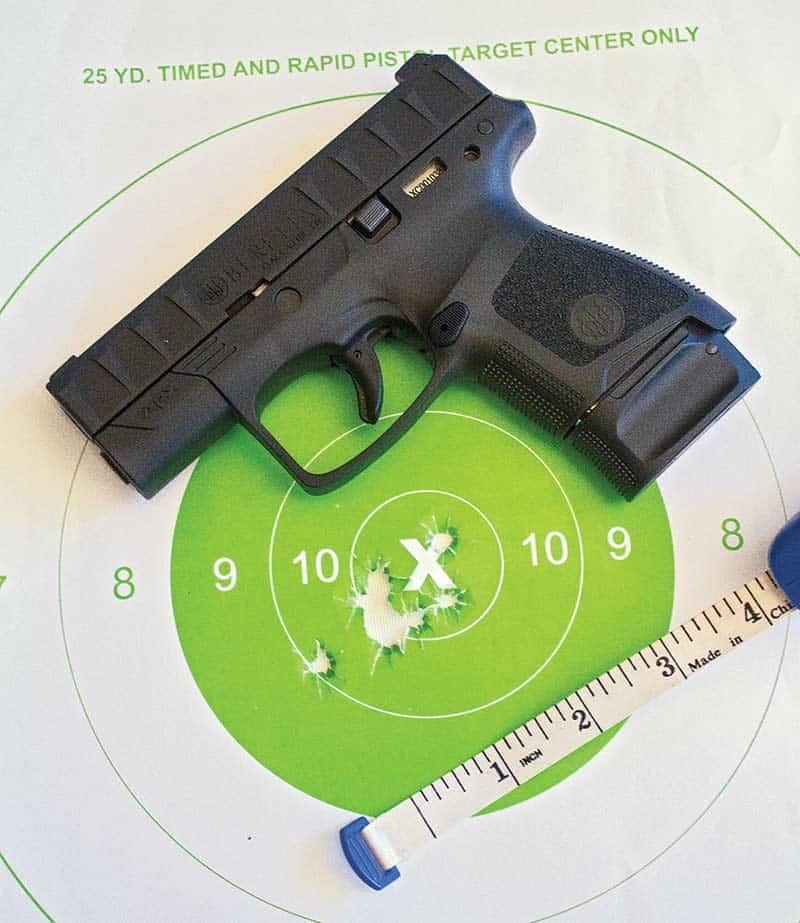Beretta APX
Slimmed-down Spicy Italian
Beretta came relatively late to the polymer striker-fired “service pistol” market, but their Apex in this format has drawn raves from most reviewers. Beretta included a chopped and channeled version — still with a double-stack magazine — they call the APX Compact. But the concealed carry/off duty gun market has an insatiable desire for smaller, slimmer 9mm pistols, and to satisfy this large niche now comes the Beretta APX Carry. It uses what might be called a “semi-single stack” magazine, à la GLOCK’s recently introduced G48 and G43X.
The slide is pure APX in appearance with its distinctive wide-apart grasping ridges running the entire slide length except for flat spots by the ejection port, but the rest of the pistol harkens to an earlier Beretta pocket 9mm, the Nano of 2011.
I asked Erik Stern, Beretta Product Manager for Tactical Products and Pro Shop, about how much of this pistol’s design DNA came from the Nano series, and how much from the service-size APX.
Stern says, “The APX Carry replaces the Nano. The Nano has been around since 2011 and was good in its time, but the APX is better, primarily with ergonomic issues. We changed the shape to bring the hand up significantly in the back of the grip. You have more purchase with the hand on the frame. Feedback on regular APX has been wonderful. The APX Compact was a little chunky; we wanted the APX Carry to be pocket size. We learned a lot with the APX.”
Initial Impressions
This little pistol comes out of the box weighing just under 20 oz. and includes a nice little nylon carry case for the pistol; an eight-round extended mag; a six-round magazine with a pinky rest and a flush floorplate for the latter to give a third configuration option.
Stern was right about the “ergos.” The old Nano pointed low in my hand, something of a deal-breaker for me but the APX Carry pointed where I wanted it — if I closed my eyes and brought it up to the target, it was spot-on when I opened my eyelids. Trigger reach was perfect for my average-sized adult male hand, too. The sights were decent: big and blocky with a single non-illuminated white dot up front.
The front and back of the grip-frame are aggressively stippled and the gun never moved in our hands when we shot it. Recoil wasn’t bothersome for anyone who shot it, including female instructors. All testers of both genders preferred the long magazine for shooting because it gave a firm purchase for all the fingers. The flanged mag came halfway down my pinky finger — not comfortable at all. The flush-bottom magazine conceals the best, at the price of two less rounds on board, and tucking the pinky tightly under the butt still affords a solid firing grasp. Only one tester felt the aggressive checkering was uncomfortable in firing.
A huge tactical advantage of the APX Carry, which I’m surprised Beretta doesn’t advertise, is the recoil spring guide design allows the gun to fire at press-contact — it won’t go out of battery and become unshootable if you have to put it directly against an assailant’s body to fire, sometimes necessary when you’re in a belly-to-belly struggle with a criminal trying to murder you.
Trigger Pull
The most polarizing thing about the APX Carry among shooters will be, I guarantee, the trigger.
A Lyman digital trigger gauge showed the average pull weight to be 7.19 lbs. But the story of the Carry’s trigger goes far beyond its weight — the pull is LO-O-ONG and as with the Nano preceding it, there’s a reason.
Erik Stern told me, “This pistol is absolutely drop-safe. It has a passive firing block, trigger safety that interacts with chassis and frame like the APX. This is a non-pre-cocked striker, double-action style. You have a long, deliberate pull. That’s a lot more forgiving in pocket, off-body, or non-traditional carry.”
Magazines: APX vis-à-vis Nano
Some reviews have stated APX magazines are interchangeable with earlier Nano mags. Alert! — this turns out to be not entirely true.
Erik Stern explains, “We have changed the body, springs and followers. However, Nano magazines could be used in APX carry at the range but shouldn’t be for defense use. Like anything else, if you expect it to perform at its best, you should use correct OEM mags.” However, an APX Carry magazine is apparently an upgrade when used in a Nano. How would a Nano owner who bought an APX Carry keep from mixing up the magazines? Erik told us, “The floorplate on the Nano is a flat piece, non-textured on extension and flat bottom, and also longer on the six-round baseplate at the rear. The Nano has a laser weld seam on the back; the APX magazine does not.”
Accuracy
On the 25-yard line, America’s most ubiquitous 9mm practice load, the 115-grain FMJ Winchester White Box, grouped 5-3/4″ for all five shots, with three of them in the 10 ring including a tie-breaker center X, with one clipping the nine-ring and another out in the seven zone. Those three “10s” were in a more pleasing 2-7/8″ group. Score was 45 out of 50 possible points, or a respectable 90%.
On the other end of the power scale in the Winchester 9mm line is my general carry favorite, the Ranger-T 127 grain +P+. Recoil was snappier, of course, but this turned out to be the ammo the baby Beretta liked most. The whole five-shot group measured only 2-1/4″ with the best three in 1-5/16″. The whole group was slightly right of center, or the target score would have been a perfect “possible”; as it was, the tally was three-10s including an X, and two nines. This came out to 48 out of 50, or 96%. All things considered, damn good for a pocket pistol.
But how did it do from the easier seven-yard line? I inserted the eight-round mag after chambering a ninth round and fired the APX Carry from a solid Isosceles standing position. On one of the same B8 targets, I was rewarded with all nine inside the 10 ring and eight of those in the tie-breaking center X ring, a 100% score. The nine-shot cluster measured an inch and thirteen-sixteenths, and seven of those were in a sub-inch one-hole group. I couldn’t ask for more than this, and I’m sure the one bullet hole that escaped the X ring was my fault, not the Beretta’s.
Conclusions
At $460 MSRP, the APX Carry is designed to compete with concealment pistols such as the super-popular S&W M&P Shield. I was happy with its accuracy, feel, ease of carry and overall “shootability.” A few testers experienced a bit of a finger pinch at the toe of the trigger; this seems dependent on finger shape, and if it’s a problem you’ll pick up on in the gun shop before you put your money down.
The only real complaints we had were about the length of the trigger pull, all from testers who spend most of their time shooting GLOCKs and other pistols they’ve become accustomed to firing with a short stroke on the trigger. As Erik Stern said, the APX Carry was expressly designed to have a trigger that felt like a double-action pocket revolver. If you are accustomed to the latter — or to a Kahr or other double-action auto pistol — and looking to switch to a flat auto with nine rounds instead of five or six, you and the APX Carry will very likely experience “love at first shot.” If you aren’t, your trigger finger will want a definite re-acclimation period to bond with this very useful little self-defense pistol.








